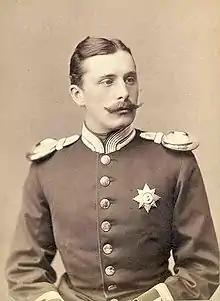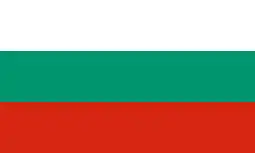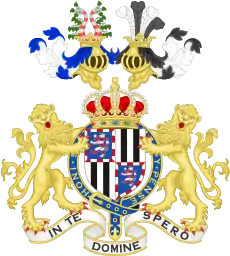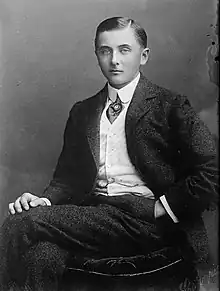| Prince Henry | |
|---|---|
 Prince Henry c. 1885 | |
| Born | 5 October 1858 Milan, Lombardy–Venetia, Austrian Empire |
| Died | 20 January 1896 (aged 37) HMS Blonde, near Sierra Leone |
| Burial | 5 February 1896 |
| Spouse | |
| Issue | |
| Family | Battenberg |
| Father | Prince Alexander of Hesse and by Rhine |
| Mother | Julia, Princess of Battenberg |
| Occupation | Military |
Prince Henry of Battenberg KG PC (Henry Maurice; 5 October 1858 – 20 January 1896), formerly Count Henry of Battenberg, was a morganatic descendant of the Grand Ducal House of Hesse. He became a member of the British royal family by marriage to Princess Beatrice of the United Kingdom, the youngest child of Queen Victoria. Through his daughter, Victoria Eugenie, who became the queen consort of Spain, Henry is a direct ancestor of current members of the Spanish royal family.
Early life
Henry was born on 5 October 1858 in Milan, Lombardy–Venetia. He was the son of Prince Alexander of Hesse and by Rhine, and his wife Countess Julia von Hauke. His father was the third son and fourth child of Grand Duke Ludwig II of Hesse and Wilhelmina of Baden.
His parents' marriage was morganatic, as Julia was not considered a proper wife for a prince of a reigning dynasty, being only a countess. As such, at the time of his birth, Henry could not bear his father's title or name, and was styled His Illustrious Highness Count Henry of Battenberg. He was known as 'Liko' to his family. When his mother was raised to Princess von Battenberg and given the higher style of Her Serene Highness by Alexander's older brother, Louis III, Grand Duke of Hesse, Henry and his siblings shared in their mother's new rank. He became His Serene Highness Prince Henry of Battenberg, although he remained ineligible to inherit the throne of Hesse or to receive a civil list stipend.
Prince Henry received a military education and took up a commission as a lieutenant in the 1st Regiment of the Rhenish Hussars in the Prussian Army. He served in the Prussian Garde du Corps and was also Honorary Colonel of the 1st Infantry Regiment of Bulgaria,[1] where his brother Alexander was Prince.
Marriage
Because of their close relationship to the Grand Ducal House of Hesse, the Battenbergs came into close contact with various ruling families of Europe, including the British Royal House. In April 1884, Henry's elder brother, Prince Louis of Battenberg, married Princess Victoria of Hesse and by Rhine, his first cousin once-removed, and a granddaughter of Queen Victoria, Empress of India. Shortly after that wedding, Prince Henry became engaged to Princess Beatrice, fifth daughter and youngest child of Queen Victoria and Albert, Prince Consort. Queen Victoria agreed to the marriage on the condition that the couple make their home with her. The Queen-Empress formally gave her consent to the marriage at a meeting of Her Majesty's Most Honourable Privy Council on 27 January 1885.[2]
On 22 July 1885, the Queen made Prince Henry a Knight of the Garter, and granted him the style Royal Highness to give him rank equal to his wife.[3] This style took effect in the United Kingdom, but not in the German Empire (where the Prince was still considered a Serene Highness).[4]
Beatrice and Henry were married at St Mildred's Church at Whippingham, near Osborne,[5] on 23 July 1885.[6][7] On the same day, a bill to naturalise Prince Henry a British subject passed the House of Lords. The couple adopted the style, Their Royal Highnesses Prince and Princess Henry of Battenberg.
On 22 August 1885, exactly a month after the wedding, Henry was made Honorary Colonel of the 5th (Isle of Wight, Princess Beatrice's) Volunteer Battalion, the Hampshire Regiment,[8] In early 1886, it was announced in The Times that he would be made a captain in the 1st Life Guards, but the Secretary of State for War denied knowledge of this in the House of Commons and the appointment did not take place.[9]
Prince and Princess Henry of Battenberg had four children. By royal warrant of 13 December 1886, the Queen granted their children the style Highness.[10] This style took immediate effect in the United Kingdom and elsewhere except within the German Empire, where, as Princes and Princesses of Battenberg, they were only entitled to the style Serene Highness.[4]
Later life and death

In 1889 Prince Henry was made Governor of Carisbrooke Castle and Captain-General and Governor of the Isle of Wight.[11] He was made Lieutenant-Colonel in the Army on 21 June 1887,[12][13] Colonel on 22 February 1893[14] and appointed to the Privy Council on 20 November 1894.[15]
In November 1895, Prince Henry persuaded Queen Victoria to allow him to go to West Africa to fight in the Ashanti War. He served as the military secretary to the commander-in-chief of British forces, General Sir Francis Scott. He contracted malaria when the expedition reached Prahsu, about 30 miles (50 km) from Kumasi, and subsequently died aboard the cruiser HMS Blonde stationed off the coast of Sierra Leone. His body was repatriated by the cruiser HMS Blenheim from the Canary Islands and his funeral service took place on 5 February 1896, at the same St. Mildred's Church, Whippingham on the Isle of Wight where he had been married. Interment followed in what became known as the Battenberg Chapel.[16] The remains of his wife, Princess Beatrice, were placed there in August 1945 and those of his eldest son, the Marquess of Carisbrooke, in July 1961.
Beatrice's sister Louise told Sir James Reid of "Prince Henry's attempted relations with her, which she had declined."[17]
Victoria erected a memorial in the form of a Celtic cross to Prince Henry near Connachat Cottage in the grounds of Balmoral Castle in 1896. It is inscribed 'Brief Life! In sport and war so keen, morned by these winds in heath and fir as where the falling breakers stir the pains that crowned thy closing scene'.[18]
Titles, styles, honours and arms
Titles and styles
- 5 October 1858 – 21 December 1858: His Illustrious Highness Count Henry of Battenberg
- 21 December 1858 – 20 January 1896: His Serene Highness Prince Henry of Battenberg
- In the UK: 22 July 1885 – 20 January 1896: His Royal Highness Prince Henry of Battenberg
Honours
 Hesse and by Rhine:[19]
Hesse and by Rhine:[19]
- Grand Cross of the Merit Order of Philip the Magnanimous, with Swords, 18 May 1875[20]
- Grand Cross of the Ludwig Order, 23 April 1885[20]
 United Kingdom:
United Kingdom:
- KG: Knight of the Garter, 23 July 1885[21]
- Queen Victoria Golden Jubilee Medal, 1887[19]
- PC: Privy Counsellor, 20 November 1894[15]
 Bulgaria:[19]
Bulgaria:[19]
- Grand Cross of St. Alexander
- Commemorative Medal for the Liberation of Bulgaria
.svg.png.webp)
.svg.png.webp)
.svg.png.webp) Ernestine duchies: Grand Cross of the Saxe-Ernestine House Order[19]
Ernestine duchies: Grand Cross of the Saxe-Ernestine House Order[19] Mecklenburg: Grand Cross of the Wendish Crown, with Golden Crown[19]
Mecklenburg: Grand Cross of the Wendish Crown, with Golden Crown[19].svg.png.webp) Montenegro: Grand Cross of the Order of Prince Danilo I[19]
Montenegro: Grand Cross of the Order of Prince Danilo I[19].svg.png.webp) Ottoman Empire: Order of Osmanieh, 1st Class[19]
Ottoman Empire: Order of Osmanieh, 1st Class[19].svg.png.webp) Portugal: Grand Cross of the Tower and Sword[19]
Portugal: Grand Cross of the Tower and Sword[19].svg.png.webp) Prussia: Grand Cross of the Red Eagle[19]
Prussia: Grand Cross of the Red Eagle[19] Romania: Grand Cross of the Star of Romania[19]
Romania: Grand Cross of the Star of Romania[19].svg.png.webp) Serbia: Grand Cross of the Cross of Takovo[19]
Serbia: Grand Cross of the Cross of Takovo[19]
Arms

Issue
| Image | Name | Birth | Death | Notes |
|---|---|---|---|---|
 | Prince Alexander of Battenberg later Alexander Mountbatten, 1st Marquess of Carisbrooke | 23 November 1886 | 23 February 1960 | Married, 1917 Irene Denison (4 July 1890 – 16 July 1956); had issue. |
 | Princess Victoria Eugénie of Battenberg | 24 October 1887 | 15 April 1969 | Married, 1906, Alfonso XIII of Spain (17 May 1886 – 28 February 1941); had issue. |
 | Prince Leopold of Battenberg later Lord Leopold Mountbatten | 21 May 1889 | 23 April 1922 | Suffered from haemophilia; died unmarried and without issue during a knee operation. |
 | Prince Maurice of Battenberg | 3 October 1891 | 27 October 1914 | Killed in action during World War I. |
Ancestry
| Ancestors of Prince Henry of Battenberg | |||||||||||||||||||||||||||||||||||||||||||||||||||||||||||||||||||||||||||||||||||||||||||||||||||||||||||||||||||||||||||||||||||||||||||||||||||||||||||||||||||||||||||||||||||||||||||||||||||||||||||||||||||||||||||||||||||||||||||||||||||||||||||||||||||||||||||||||||||||||||
|---|---|---|---|---|---|---|---|---|---|---|---|---|---|---|---|---|---|---|---|---|---|---|---|---|---|---|---|---|---|---|---|---|---|---|---|---|---|---|---|---|---|---|---|---|---|---|---|---|---|---|---|---|---|---|---|---|---|---|---|---|---|---|---|---|---|---|---|---|---|---|---|---|---|---|---|---|---|---|---|---|---|---|---|---|---|---|---|---|---|---|---|---|---|---|---|---|---|---|---|---|---|---|---|---|---|---|---|---|---|---|---|---|---|---|---|---|---|---|---|---|---|---|---|---|---|---|---|---|---|---|---|---|---|---|---|---|---|---|---|---|---|---|---|---|---|---|---|---|---|---|---|---|---|---|---|---|---|---|---|---|---|---|---|---|---|---|---|---|---|---|---|---|---|---|---|---|---|---|---|---|---|---|---|---|---|---|---|---|---|---|---|---|---|---|---|---|---|---|---|---|---|---|---|---|---|---|---|---|---|---|---|---|---|---|---|---|---|---|---|---|---|---|---|---|---|---|---|---|---|---|---|---|---|---|---|---|---|---|---|---|---|---|---|---|---|---|---|---|---|---|---|---|---|---|---|---|---|---|---|---|---|---|---|---|---|---|---|---|---|---|---|---|---|---|---|---|---|---|---|---|---|
| |||||||||||||||||||||||||||||||||||||||||||||||||||||||||||||||||||||||||||||||||||||||||||||||||||||||||||||||||||||||||||||||||||||||||||||||||||||||||||||||||||||||||||||||||||||||||||||||||||||||||||||||||||||||||||||||||||||||||||||||||||||||||||||||||||||||||||||||||||||||||
References
- ↑ "No. 26712". The London Gazette. 17 February 1896. p. 955.
- ↑ "No. 25436". The London Gazette. 27 January 1885. p. 357.
- ↑ "No. 25493". The London Gazette. 24 July 1885. p. 3425.
- 1 2 Dennison, M., The Last Princess, p.150
- ↑ Beatrice and her siblings were confirmed here
- ↑ Purdue (2004). "Beatrice, Princess; Battenberg, Prince Henry of". Oxford Dictionary of National Biography (online ed.). Oxford University Press. doi:10.1093/ref:odnb/30658. Retrieved 8 November 2007. (Subscription or UK public library membership required.)
- ↑ "No. 25495". The London Gazette. 28 July 1885. p. 3529.
- ↑ "No. 25503". The London Gazette. 21 August 1885. p. 3948.
- ↑ "Army Prince Henry of Battenberg (1886)". Parliamentary Debates (Hansard). House of Commons. 26 February 1886. Retrieved 28 April 2020.
- ↑ "No. 25655". The London Gazette. 14 December 1886. p. 6305.
- ↑ Dennison, M., The Last Princess, p.182-183
- ↑ "No. 25712". The London Gazette. 21 June 1887. p. 3366.
- ↑ "No. 25773". The London Gazette. 5 January 1888. p. 223.
- ↑ "No. 26374". The London Gazette. 21 February 1893. p. 946.
- 1 2 "No. 26573". The London Gazette. 23 November 1894. p. 6625.
- ↑ "No. 26712". The London Gazette. 17 February 1896. p. 953.
- ↑ Stamp, Robert (1 May 1988). Royal rebels: Princess Louise & the Marquis of Lorne. Dundurn Press. ISBN 9781550020397.
- ↑ Historic Environment Scotland. "Connachat, Prince of Battenberg Memorial (Category C Listed Building) (LB51502)". Retrieved 20 April 2023.
- 1 2 3 4 5 6 7 8 9 10 11 "Genealogy", Hof- und Staats-Handbuch des Großherzogtum Hessen (in German), Darmstadt: Im Verlag der Invalidenanstalt, 1896, p. 5 – via hathitrust.org
- 1 2 Großherzoglich Hessische Ordensliste (in German), Darmstadt: Staatsverlag, 1894, pp. 5, 36 – via hathitrust.org
- ↑ Shaw, Wm. A. (1906) The Knights of England, I, London, p. 67
